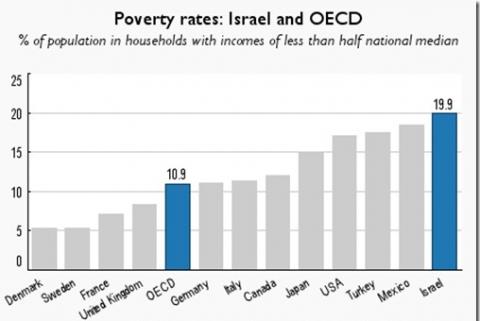Tax data: Half of all Israelis earn under NIS 5,812 a month
The average wage, which is reported monthly, measures all the salaries earned by employees in Israel divided by the number of workers. It is a less representative measure of the state of the economy than the median wage, because it is swayed by extreme wage levels. The stats bureay says it doesn't regularly report the median wage because the data at its disposal would not yield a sufficiently accurate figure.
When it comes to the average gross wage, as opposed to the median gross salary, the CBS says in April the figure stood at NIS 8,881 - but 65% of employees earned less than that, a clear indication of major wage disparities in the workplace.
The gross median income is not influenced by very high wages at the top of the pay scales. The difference between the average salary and the median average salary is a common measure of economic disparity: the greater the difference, the more the economic inequality in a country.
A calculation of the average and median net take-home pay, after deductions, reveals a 14.5% discrepancy. This compares to a 30.8% disparity in Mexico and a 16.3% discrepancy in the United States. The Tax Authority's data on median wages was based on 2010 wages because the information necessary to make the calculation is only available two years after the fact. It is based on reporting of over 3 million workers' salaries between 2008 and 2010. In 2010, the average gross salary was NIS 8,836, the Tax Authority says, a figure that is pulled upward by high salaries at the top.
Public doesn't know
By one measure, the middle class can be defined as those between the 75th and 25th percentiles of the wage hierarchy, which translates into a monthly gross wage of between NIS 3,451 and NIS 10,243. "The middle class is closer to the lower class than the upper class based on that measure," says Prof. Ayal Kimhi, an economics professor at Hebrew University and deputy director of the Taub Center. Recently involved in measuring economic inequality in the country, he found that a disproportionate amount of wealth was concentrated at the top off the ladder.
The median gross wage figures cover wage-earners between ages 18 and 70 - part-time employees as well as full-time and over-time workers - although migrant workers were not included. The data only relates to income reported to the Tax Authority. Economists say it nonetheless reflects a more accurate picture than the average wage.
Kimhi acknowledges that the median wage is skewed by part-time workers' salaries, but adds: "Here, too, we have to ask if the fact that someone is working part-time is by choice or because that is all he can get. If it involves a couple, one of whom works part-time, they can manage, but if both their salaries together is at the 25th percentile, they have a problem."
In 2010, the gross salary of a worker in the 25th percentile was NIS 3,451 a month, which, factoring in inflation, would amount to NIS 3,573 in real terms today. This puts it about NIS 650 lower than the minimum wage for full-time employees, although not all of these people are working full-time. The poverty line in 2010 was set at NIS 2,413 a month for an individual and NIS 3,861 per month for a couple.
By Lior Dattel

